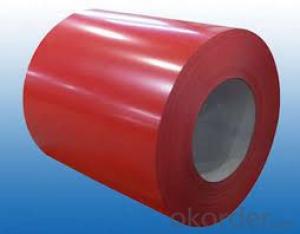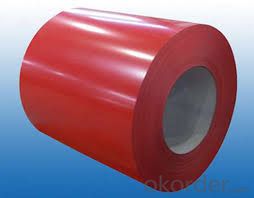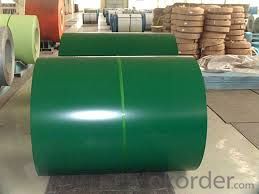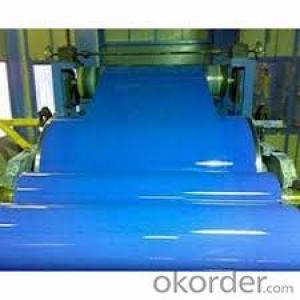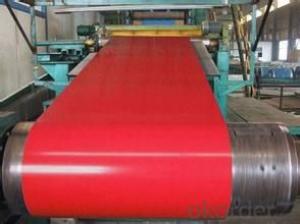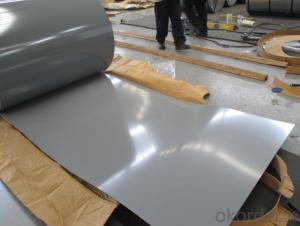Prepainted Galvanized Rolled Steel Coil/Sheet-CGCC
- Loading Port:
- Tianjin
- Payment Terms:
- TT OR LC
- Min Order Qty:
- 30 m.t.
- Supply Capability:
- 500000 m.t./month
OKorder Service Pledge
OKorder Financial Service
You Might Also Like
Specifications
Thickness: 0.186-0.8mm (BMT) Width: 1000-1250mm |
Zinc Coating: 80-275g/m2 |
Color: According to RAL color fan or as per request |
Internal Diameter: 508mm or 610mm |
Coil Weight : 4-8MT |
Quality : Commercial and structural quality |
Paint : Polyester paint for topside, epoxy for reverse |
Standard: JIS G 3312, ASTM A755M, EN 10169 |
Base Steel Grade: SGCC,SGCD,DX51D+Z,DX52D+Z;S200GD,S220GD,S280GD,S350G D,CS, FS,SS |
Applications:
It can be widely used in transportation, light industry, civil usage and farming. It is also the perfect building material in construction for making steel roofing,insulation panel, corrugate sheet, facade wall,shutters,T-bar and home appliance.
Packaging & Delivery:
The packing of coils consists of anti-damp paper, PVC film, hardboard paper, steel box, strapped with steel strips, fitted with locks and edge protectors and guarantees the optimal condition of the delivered goods. Each coil can be additionally fitted with wooden/steel skids(eye to the side) or wooden pallets(eye to the sky).
Images:

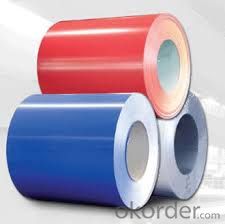
- Q: What are the different coil packaging materials used for steel coils?
- There are several different coil packaging materials used for steel coils, each offering unique properties and benefits. Some of the most common materials include: 1. Stretch film: This is a popular choice for coil packaging due to its excellent flexibility and ability to tightly wrap around the coil. Stretch film provides good protection against dust, moisture, and scratches. 2. Steel strapping: Steel strapping is a robust and durable option for securing steel coils. It offers high tensile strength and resistance to breakage, ensuring the coils remain tightly bound during transport or storage. 3. Plastic strapping: Plastic strapping is a lightweight and cost-effective alternative to steel strapping. It offers good shock absorption and is resistant to rust and corrosion. Plastic strapping is often used for smaller or lighter steel coils. 4. Paperboard: Paperboard is a recyclable and eco-friendly packaging material. It provides a protective layer against dust and minor impacts, while also allowing slight breathability to prevent moisture buildup. 5. Wooden crates: Wooden crates are commonly used for large or heavy steel coils. They offer sturdy support and protection, preventing any damage during handling, transportation, or storage. 6. Corrugated cardboard: Corrugated cardboard is a versatile and lightweight packaging material suitable for smaller steel coils. It provides cushioning and protection against minor impacts, as well as being easily recyclable. The choice of coil packaging material depends on various factors such as the size and weight of the steel coils, transportation requirements, and desired level of protection. Each material has its own advantages and should be selected based on the specific needs of the steel coil packaging.
- Q: What are the different methods of transporting steel coils?
- Depending on factors such as weight, size, and distance, there are various methods available for transporting steel coils. These include: 1. Flatbed trucks: Steel coils can be transported on flatbed trucks, which have a spacious open platform for easy loading and unloading. This option is commonly used for shipments of short to medium distances and provides convenient access to the coils. 2. Rail transport: Steel coils can also be transported by rail using specialized coil cars with curved interiors to securely hold the coils. Rail transport is often preferred for long-distance shipments due to its cost-effectiveness and capacity to handle large quantities. 3. Shipping containers: Steel coils can be loaded into shipping containers for transportation via sea or inland waterways. To prevent movement during transit, the coils are usually secured inside the container using bracing or blocking materials. This method is commonly employed for international shipments and facilitates easy handling and transfer between different modes of transportation. 4. Barges: In some cases, steel coils can be transported on barges along rivers, canals, or other inland waterways. Barges are particularly suitable for large and heavy shipments, offering a cost-effective and efficient means of transportation. 5. Roll-on/roll-off (RoRo) vessels: RoRo vessels are specialized ships designed to transport vehicles and large cargo that can be rolled on and off the ship. Steel coils can be loaded onto trailers or flatbeds and driven onto the vessel, providing a convenient transportation option. 6. Air freight: Although less common due to higher costs, steel coils can also be transported by air. This method is typically used for urgent and time-sensitive shipments or when the distance is too great for other modes of transportation. Air freight offers the advantage of speed and can be a viable option in certain situations. In conclusion, the choice of transportation method for steel coils depends on factors such as cost, distance, time frame, and logistical requirements. Freight forwarders and logistics providers can assist in determining the most suitable method for a specific shipment.
- Q: What are the different types of steel alloys used in coil manufacturing?
- There are several different types of steel alloys used in coil manufacturing, including carbon steel, stainless steel, and high-strength low-alloy (HSLA) steel. Carbon steel is the most commonly used alloy, known for its high strength and durability. Stainless steel is used for its corrosion resistance and aesthetic appeal. HSLA steel offers a combination of strength, formability, and weldability, making it suitable for various applications in coil manufacturing.
- Q: How do steel coil manufacturers handle product recalls?
- Steel coil manufacturers handle product recalls by following a systematic process. Firstly, they identify the specific batches or lots of steel coils that need to be recalled based on quality or safety concerns. Then, they promptly notify their distributors, customers, and regulatory authorities about the recall, providing all relevant information. The manufacturers work closely with these stakeholders to ensure that the affected coils are returned or replaced. Additionally, they investigate and address the root cause of the issue to prevent similar recalls in the future, implementing necessary quality control measures and process improvements.
- Q: I know there is soft steel and sturdier steel they use in products. The sturdier often used for equipment that requires more durability when in operation.
- It kind of depends on the application. It can be anywhere from simple to very difficult depending on what exactly you are talking about. Hardening a small piece of carbon tool steel for a chisel or punch consists of simply heating it till its red hot and then quenching it in water. This is done after the tool is formed. Hardening also means making the steel brittle, so it must be tempered after hardening to make it hard and strong. Hardening large or huge pieces like that used for equipment is done at the foundry, where they have equipment to do such a job.
- Q: What are the different methods of surface cleaning for steel coils?
- There are several different methods available for surface cleaning of steel coils. The choice of method depends on the specific requirements and conditions. 1. Mechanical Cleaning: This method involves the use of mechanical tools such as wire brushes, sanding discs, or abrasive pads to physically remove dirt, rust, or other contaminants from the surface of the steel coils. It is commonly used for light cleaning and can be done manually or with the help of automated equipment. 2. Chemical Cleaning: Chemical cleaning involves the use of various cleaning agents or solvents to dissolve or loosen contaminants from the surface of steel coils. This method is effective for removing oil, grease, or stubborn dirt. Different chemicals can be used depending on the type of contaminants and the desired level of cleaning. It is important to follow safety guidelines and use appropriate protective equipment when using chemical cleaners. 3. Power Washing: Power washing or pressure washing utilizes a high-pressure water jet to remove loose particles, dirt, or contaminants from the surface of steel coils. This method is effective for large-scale cleaning and can be combined with chemical cleaners for enhanced results. It is important to adjust the water pressure according to the type of surface and use appropriate nozzles to prevent damage. 4. Pickling: Pickling is a chemical cleaning method that involves the immersion of steel coils in an acidic solution, typically a mixture of hydrochloric acid and sulfuric acid. This process removes scale, oxides, and other impurities from the surface of the steel. Pickling is commonly used for heavy-duty cleaning and preparation of steel coils before further processing or coating. 5. Electrolytic Cleaning: Electrolytic cleaning utilizes an electric current to remove contaminants from the surface of steel coils. The coils are immersed in an electrolyte solution, and the application of a direct current causes the contaminants to dissolve or dislodge from the surface. This method is particularly effective for removing rust or corrosion and can be used in conjunction with other cleaning methods. It is important to consider factors such as the type and condition of the steel coils, the level of cleanliness required, and any specific industry standards or regulations when choosing the appropriate method of surface cleaning. Regular maintenance and cleaning of steel coils are essential to ensure their longevity, performance, and resistance to corrosion.
- Q: Having a new kitchen and would like to know the pros and cons of stainless steel as opposed to white appliances. I can only think of finger marks on the SS, which I believe are difficult to remove. Anyone had both that they could advise please?
- I have Stainless Steel and YES it shows finger prints etc, Since there are no children around it's easier to keep clean, but one word of caution when using commercial SS cleaners, if the spray gets onto the floor it's almost impossible to get off and makes it slippery as ice. I'd use newspaper before using a SS cleaner,, I've had both and would opt for WHITE in any case. So easy to maintain, Now, they do make a Faux SS, which is very nice., and don't show any markings at all, our Son has one and with 3 kids in the house constantly using the Fridge it's been great, you might want to look into that..
- Q: How are steel coils inspected for flatness using optical sensors?
- The process of inspecting the flatness of steel coils involves the use of optical sensors, which are part of a system known as optical flatness measurement. This system employs high-resolution cameras to capture images of the steel surface as it passes through the inspection line. To begin, the steel coil is unwound and conveyed over a roller table. While in motion, the optical sensors are positioned above the coil to capture images at regular intervals. These sensors are typically a combination of laser line projectors and high-resolution cameras. The laser line projectors emit a thin, straight line of laser light across the width of the steel coil. This laser line serves as a reference plane for measuring the flatness of the steel surface. Subsequently, the high-resolution cameras capture images of the laser line interacting with the steel coil. The captured images are then subjected to analysis using advanced image processing algorithms. These algorithms examine the deformation of the laser line on the steel surface and calculate the deviations from the flat reference plane. These deviations indicate any irregularities or variations in the flatness of the steel coil. The optical sensors possess the capability to accurately detect even the most minute deviations in flatness, measuring them in micrometers or smaller units. This enables manufacturers to identify and correct any flatness issues in the steel coils before further processing or shipment. In addition to measuring flatness, optical sensors can also identify other surface defects such as waviness, scratches, or dents. By incorporating multiple cameras and laser line projectors from different angles, a comprehensive inspection of the steel coil's surface can be achieved. Overall, the utilization of optical sensors for inspecting steel coil flatness offers a swift, precise, and non-contact method. By identifying and addressing any flatness issues early in the production process, manufacturers can guarantee the delivery of top-quality steel products to their customers.
- Q: I'm looking for steel to make knives, but don't know what to get.
- that's a hard one, right here is why. once you like a truck you do no longer want a Porche and vice versa. In different words have been one steel excels the different is unfavorable. For overallstrengthh i like 5160, for organic area retaining i like D2, O-a million and 52100 are probable the appropriate carbonsteel in area retaining. in case you like a knife with corrosion resistance then stainless is the appropriate determination. yet stainless needs to cryo dealt with to benefit the finished skill of the steel. I don'trecommendinless for any blade over 5 as a results of fact the greater desirable grain shape won't be able to take flexing and could wreck. For a heavy accountability super knife I recomend carbon steel with a differential temper as carried out good it may flex without breaking. What does all this mean? the appropriate steel is not any further effective than a decrease high quality steel if there's a deffitiancy in warmth therapy or layout. D-2 has not greater reducing potential than 440c at 57r. i do no longer use stainless in my knives as they're puzzling to warmth manage, D-2 case in point, fifty deg. in the two direction from the hardening temp (which ought to be held for minimum of 20-half-hour) can mean 2 factors Rockwell. All stainless are this type, as such maximum manufactures in no way comprehend the potetiel of the steel. right here is what i exploit, on a small knife have been i want greater effective area retaining from a greater durable temper (60r) i like O-a million, W-a million and 52100. For greater desirable knives L-6 works properly. For a survival/attempt against knife 5160 is my determination. those are not the only steels accessible, the books are full of them. solid luck.
- Q: What are the common coil slitting equipment used in the industry?
- The common coil slitting equipment used in the industry include slitting lines, slitter knives, and tension stands. Slitting lines are machines used to cut a large coil into smaller coils of desired widths. Slitter knives are sharp blades mounted on the slitting line that perform the cutting process. Tension stands are used to control the tension of the coils during the slitting process, ensuring smooth and accurate cuts.
Send your message to us
Prepainted Galvanized Rolled Steel Coil/Sheet-CGCC
- Loading Port:
- Tianjin
- Payment Terms:
- TT OR LC
- Min Order Qty:
- 30 m.t.
- Supply Capability:
- 500000 m.t./month
OKorder Service Pledge
OKorder Financial Service
Similar products
Hot products
Hot Searches
Related keywords
